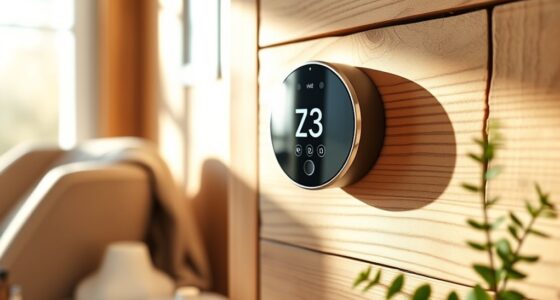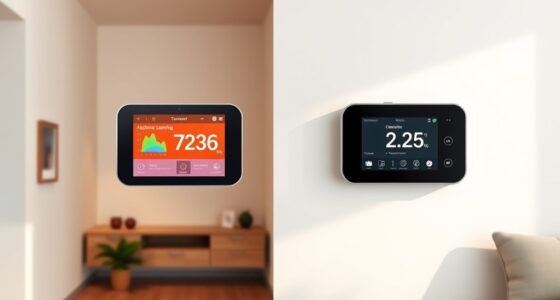When buying a smart thermostat for a multi-story home, look for models that support multiple zones or sensors to guarantee even temperature control across floors. Choose a device with Wi-Fi connectivity, so you can manage your home’s climate remotely. Placement matters—install sensors away from heat sources and drafts for better accuracy. Compatibility with your HVAC system is essential, and professional installation can prevent issues. If you want to learn more, keep exploring these key tips for a smarter, more comfortable home.
Key Takeaways
- Choose a smart thermostat with multiple sensors or zoning support for precise temperature control across floors.
- Ensure proper placement away from heat sources, direct sunlight, and drafts for accurate readings.
- Verify compatibility with your existing HVAC system and Wi-Fi connectivity for remote management.
- Opt for models with learning algorithms and scheduling features to adapt to household routines.
- Consider professional installation to optimize sensor placement and system integration for maximum efficiency.

Have you ever noticed uneven temperatures across different floors in your home? It can be frustrating to feel like some rooms are too hot while others are chilly, especially in a multi-story house. This common issue often stems from how traditional thermostats regulate temperature, relying on a single sensor that doesn’t account for the different conditions on each floor. Upgrading to a smart thermostat can dramatically improve your home’s comfort and energy efficiency. These devices use advanced sensors, Wi-Fi connectivity, and learning algorithms to optimize heating and cooling, making sure each level gets the right amount of climate control. When considering a smart thermostat for your multi-story home, it’s important to focus on installation tips that ensure the device performs at its best. Proper placement is key—avoid installing the thermostat near windows, doors, or vents, because drafts or heat sources can give inaccurate readings. Ideally, position it in a central location on the main floor, away from direct sunlight or appliances that generate heat, to get a true sense of the overall home temperature. Some smart thermostats support multiple zones or sensors, which can be strategically placed on different floors or rooms to fine-tune climate control. This way, your system can respond to the specific needs of each area, reducing unnecessary heating or cooling and saving energy. When installing, follow the manufacturer’s guidelines carefully, ensuring all wiring is correct and secure, and that the device is compatible with your existing HVAC system. Many smart thermostats also come with DIY installation options, but if you’re unsure, hiring a professional can help avoid costly mistakes and guarantee ideal operation. Once installed, take advantage of the energy efficiency benefits by setting schedules that match your routine, and use the learning features to adapt over time. Some models even analyze your usage patterns and suggest adjustments to improve comfort and reduce bills. Connecting your smart thermostat to your home Wi-Fi allows you to control it remotely via smartphone apps, giving you the flexibility to make adjustments on the go. This remote access is especially useful for multi-story homes, where you might not always be in the same area to manually change settings. Additionally, proper placement of sensors can significantly enhance the accuracy and effectiveness of climate control. Incorporating zoning technology into your setup can help maintain consistent temperatures across different floors and rooms by directing airflow more precisely, which is especially beneficial for larger or multi-level houses. Overall, choosing the right smart thermostat with proper installation not only enhances your comfort but also helps you save money by making your heating and cooling systems more efficient. With the right setup, you’ll enjoy balanced temperatures across all floors and a more energy-efficient home environment.
Frequently Asked Questions
Can Smart Thermostats Control Multiple Zones in a Home?
Yes, smart thermostats can control multiple zones in your home. They often feature zoning capabilities that let you set different temperatures for various areas, enhancing comfort and energy efficiency. Proper sensor placement is vital for accurate readings, helping the thermostat adjust temperatures effectively. With these features, you can customize your home’s climate, making it more comfortable while potentially lowering energy costs.
What Is the Best Placement for Sensors in Multi-Story Homes?
You should place sensors in areas that best represent each zone’s typical temperature for effective multi-story heating. For example, install sensors on different floors, near main living spaces, and away from drafts or direct sunlight. Proper sensor placement guarantees your smart thermostat accurately monitors and adjusts heating, providing comfort across your entire home. Keep sensors at a consistent height, typically around eye level, for the most accurate readings.
How Do Smart Thermostats Adapt to Changing Weather Conditions?
Ever notice how your home’s temperature seems to shift unexpectedly? That’s where smart thermostats shine, thanks to weather adaptation and automatic temperature calibration. They detect changes in outdoor weather and adjust your indoor climate accordingly, ensuring comfort without constant manual tweaks. With built-in sensors and learning algorithms, these thermostats optimize settings, saving energy and maintaining a consistent temperature, even when the weather throws a curveball.
Are There Specific Models Recommended for Multi-Story Configurations?
You should look for models designed for multi-story homes that support zoning systems and have advanced sensor placement. These features help balance temperature differences between floors, improving comfort and efficiency. Consider thermostats with multiple sensors you can place on different levels, allowing you to customize heating and cooling zones. Brands like Ecobee and Honeywell offer such models, giving you better control over your home’s climate while saving energy.
How Energy-Efficient Are Smart Thermostats in Large Homes?
Smart thermostats are quite energy-efficient in large homes, helping you reduce overall energy consumption. They learn your schedule and optimize heating and cooling, leading to significant cost savings over time. By adjusting temperatures based on occupancy and preferences, you avoid wasting energy in unoccupied rooms. This smart control not only cuts your energy bills but also promotes a more sustainable lifestyle, making your large home more eco-friendly and economical.
Conclusion
Choosing the right smart thermostat for your multi-story home isn’t just about technology; it’s about creating a comfortable haven. Imagine your home as a symphony, where each room plays in harmony—smart thermostats help conduct that melody effortlessly. With the right device, you’ll enjoy consistent comfort and energy savings. So, don’t just settle for less; embrace the future of home climate control and turn your house into a masterpiece of coziness.









